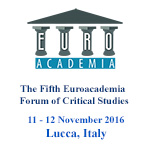Euroacademia Conferences
 Europe Inside-Out: Europe and Europeanness Exposed to Plural Observers (9th Edition) April 24 - 25, 2020
Europe Inside-Out: Europe and Europeanness Exposed to Plural Observers (9th Edition) April 24 - 25, 2020 Identities and Identifications: Politicized Uses of Collective Identities (9th Edition) June 12 - 13, 2020
Identities and Identifications: Politicized Uses of Collective Identities (9th Edition) June 12 - 13, 2020 8th Forum of Critical Studies: Asking Big Questions Again January 24 - 25, 2020
8th Forum of Critical Studies: Asking Big Questions Again January 24 - 25, 2020 Re-Inventing Eastern Europe (7th Edition) December 13 - 14, 2019
Re-Inventing Eastern Europe (7th Edition) December 13 - 14, 2019 The European Union and the Politicization of Europe (8th Edition) October 25 - 26, 2019
The European Union and the Politicization of Europe (8th Edition) October 25 - 26, 2019 Identities and Identifications: Politicized Uses of Collective Identities (8th Edition) June 28 - 29, 2019
Identities and Identifications: Politicized Uses of Collective Identities (8th Edition) June 28 - 29, 2019 The European Union and the Politicization of Europe (7th Edition) January 25 - 26, 2019
The European Union and the Politicization of Europe (7th Edition) January 25 - 26, 2019 7th Forum of Critical Studies: Asking Big Questions Again November 23 - 24, 2018
7th Forum of Critical Studies: Asking Big Questions Again November 23 - 24, 2018 Europe Inside-Out: Europe and Europeanness Exposed to Plural Observers (8th Edition) September 28 - 30, 2018
Europe Inside-Out: Europe and Europeanness Exposed to Plural Observers (8th Edition) September 28 - 30, 2018 Identities and Identifications: Politicized Uses of Collective Identities (7th Edition) June 14 - 15, 2018
Identities and Identifications: Politicized Uses of Collective Identities (7th Edition) June 14 - 15, 2018
Two Crises of Beholding: Authenticity and Identity in Michael Fried’s Art History
-
-

-
Presentation speakers
- Mathew Abbott, Federation University Australia, Victoria, Australia
Abstract:
In 1980’s Absorption and Theatricality, Michael Fried presented a new interpretation of the work of some of the greatest 18th Century French painters. He read the pictures of Jean-Baptiste-Siméon Chardin, Claude-Joseph Vernet, and Jean-Baptiste Greuze in terms of their confrontation with theatricality: the condition of artworks that have failed to manage successfully “the primordial convention” (93) that they are made for beholding. This formed the basis of his account of Manet’s achievement in 1996’s Manet’s Modernism. The key claim here is that, by the early 1860s, the problems of beholding French painters had been negotiating became unmanageable, as their anti-theatrical strategies lost their efficacy. Simultaneously acknowledging and disorienting their viewers, works such as Olympia and The Luncheon on the Grass register the coming to a head of a crisis of beholding. Against critiques of Fried’s alleged formalism, this paper seeks to show that theatricality must be understood historically: it emerges out of a field of tensions that develop dialectically, such that what appears authentic at one point in time may begin to seem unbearably contrived at another. Further, it bears an internal relationship to the development of a modern capitalist society, in which the increasing impersonality and abstraction of social and economic relations puts pressure our capacities for authentic self-determination and mutual recognition. If we read Fried’s art history in Hegelian-Marxist terms, deep connections emerge between aesthetic problems of form and content and political problems of alienation, recognition, and identity. Undermining false dichotomies between the aesthetic and the political, this account of Fried’s art historical discoveries can help clarify the grounds of the notorious attack on postmodernism presented in his 1967 essay “Art and Objecthood.” This polemic registered a second crisis of beholding: one that may have marked the end of the modernist trajectory, and the opening of a new phase in capitalism.
-
Related Presentations

The Ontological and Metaphysical Aspects of the World Coordinate System Based on the Limits of Dynamic Equilibrium
- Kozhevnikov Nikolay
- Danilova Vera

The Politics Behind Unbuilt Memory: Memorial to the Six Million Jewish Martyrs, New York /“Topography of Terror” Documentation Center, Berlin
- Anna Bernardi

From Ms. Marvel to Ms. Shabash: Sex and Power Distribution in Bangladeshi and Western Cultures
- Tahseen Salman Choudhury
- Arzoo Ismail

Institutionalised Identity
- Karolina Golinowska













